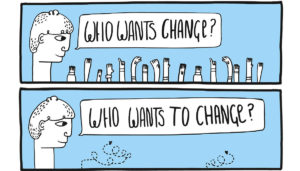One of the most critical – yet most often over-looked – factors in the success of a software implementation project is the existence of an effective Change Management plan.
In times past, when (if?) Change Management was talked about in a project context, the discussion centred on training. However, the current definition of Change Management is much broader, and covers many more components. Prosci – one the world leaders in the area – defines Change Management as:
“…the application of a structured process and set of tools to manage the people side of change from a current state to a new future state such that the desired results of the change (and expected return on investment) are achieved.”
In my opinion, the key part of this definition is the reference to a structured process and a SET of tools (not just ONE tool).
My current contract is with Spin Master – a multinational toy company. The company benefits  tremendously from the work of a small but mighty Change Management team, and this team has recently put together an excellent Change Management model for use within the organization. In fact, I believe this model is so good that I will steal from it shamelessly in the rest of this article. (Thanks, Shalini and Kaushalya!)
tremendously from the work of a small but mighty Change Management team, and this team has recently put together an excellent Change Management model for use within the organization. In fact, I believe this model is so good that I will steal from it shamelessly in the rest of this article. (Thanks, Shalini and Kaushalya!)
YOUR CHANGE MANAGMENT TOOL BOX
As mentioned above, Change Management is now defined as an entire set of tools. At Spin Master, they have 11 ‘tools’ in their set:
- Build a Communication Plan: The Comms Plan has two primary goals: (1) to create awareness and buy-in of the project through targeted communications, and (2) to communicate and highlight the benefits of the new solution. These goals are achieved by determining the audience, method and timing of communication in alignment with the project plan, and incorporating these elements into an overall awareness strategy.
- Conduct a Training Needs Analysis: This analysis prepares the project team for training by identifying skill gaps and resource requirements. Specifically, Spin Master identifies gaps between current and future state processes and technology, determines training needs and priorities and then identifies the required training resources.
- Develop a Training Plan: The training plan identifies the training deliverables and milestones. The key steps in developing the plan are (1) identifying the learning objectives, (2) designing the delivery strategy, and (3) making recommendations for content topics, flow, and delivery methodology.
- Confirmation of Training Logistics: This deliverable prepares for training by committing resources and confirming the timing of the training. The training team schedules sessions, venues, equipment, resources and participants, and ensures adequate supplies are available for the training sessions.
- Create Training Content: The primary goal of this phase is to increase training effectiveness by providing materials that follow best practices for adult learning methodology and training. This
 goal is achieved by working with Subject Matter Experts (SMEs) to draft lesson plans and training materials, and by performing quality checks to ensure training materials meet the established learning objectives. Finally, the training materials should be reviewed and approved by the SMEs and Process Owners. (One final step is to conduct knowledge checks to confirm learner’s skill retention and process/technology adoption.)
goal is achieved by working with Subject Matter Experts (SMEs) to draft lesson plans and training materials, and by performing quality checks to ensure training materials meet the established learning objectives. Finally, the training materials should be reviewed and approved by the SMEs and Process Owners. (One final step is to conduct knowledge checks to confirm learner’s skill retention and process/technology adoption.) - Develop a Sponsor Roadmap: The key steps in developing the sponsor roadmap are to (1) identify key change sponsors & change agents, (2) align on sponsorship roles and responsibilities in driving change, and (3) define key communication channels and sponsorship responsibilities.
- Confirm a Reinforcement Plan: The Reinforcement Plan reinforces both the adoption of new behaviours and the departure from old behaviours. The plan is created by: (1) establishing the methods by which you will track solution adoption, (2) assessing and monitoring user acceptance, (3) establishing a forum for user feedback, (4) implementing corrective actions, and (5) building a plan for celebrating success during implementation.
- Create an Effective Train-the-Trainor and Superuser Training Program: This program will allow SMEs to deliver training for their respective business areas and will improve long-term departmental knowledge retention and onboarding. In order for this program to be optimal, you will need to train SMEs on best practices and skills, in order for them to properly facilitate training sessions. (SMEs must learn instructional skills, along with the developing the necessary critical thinking for facilitation and trainee retention.)
- Build a Coaching Plan: This plan will provide the knowledge, training and tools to help supervisors be effective coaches, which will, in turn, create awareness and foment user buy-in. Some of the key components of this plan are: (1) identify coaching and team building activities per impacted business area, (2) prepare coaches to communicate the “what’s in it for me” message to their direct reports, (3) support delivery of targeted messages to specific audiences, and (4) track and monitor coaching effectiveness.
- Deliver a Resistance Management Plan: This plan will communicate and highlight the benefits of the change and will assess and monitor user acceptance of the solution. Specifically, the
 plan owner(s) will (1) conduct an impact analysis to identify areas of resistance, (2) develop & communicate measures to mitigate resistance, (3) inform change coaches about how to identify and respond to resistance, and (4) establish methods for long term resistance management.
plan owner(s) will (1) conduct an impact analysis to identify areas of resistance, (2) develop & communicate measures to mitigate resistance, (3) inform change coaches about how to identify and respond to resistance, and (4) establish methods for long term resistance management. - Conduct Change Agent Training: This step will prepare SMEs to champion change and mitigate resistance. Firstly, you will need to build change management capacity within the project team. Secondly, you should align on sponsor roles and responsibilities in driving the change. Lastly you will have to provide SMEs with the tools necessary for managing change.
ONE SIZE DOES NOT FIT ALL
If I can mix my metaphors a bit, do not feel compelled to use every tool in your kit on every project. Bringing unnecessary change management ‘overhead’ into projects where it is not required will certainly be counter-productive. At Spin Master, the Change Management team groups projects into one of three categories: Level 1 (Minor), Level 2 (Major) and Level 3 (Foundational). Each of these categories has a suggested list of the change management ‘tools’ which could be applicable. Again, however, this list should be reviewed at the project outset, in order to confirm that it makes sense for that particular project.
SUMMARY
Over the span of my career in IT Project and Program Management, it has become more and more obvious to me that Change Management is one of the primary contributors to a successful software implementation. By efficiently utilizing the components listed above, you will help ensure that you develop and execute an effective Change Management plan, which will dramatically improve your project’s chances for success.


